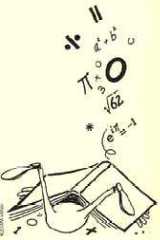Not all can throb to the music of mathematics
 MATHEMATICS is a language whose beauty can be appreciated only by those who know it. Consider Euler's famous relationship, ei = -1 (check with original). While mathematicians would find it a proposition of great elegance, most of us would be completely bewildered by such a relationship. An attempt to convey the excitement and relevance of mathematics to the general reader is therefore welcome. There are, after all, theorems in mathematics that even general readers can appreciate. Take, for instance, the proof that there is no greatest prime number. If n is the largest prime number, it is obvious that (1,2,3.... n) + 1 will also be a prime number.
MATHEMATICS is a language whose beauty can be appreciated only by those who know it. Consider Euler's famous relationship, ei = -1 (check with original). While mathematicians would find it a proposition of great elegance, most of us would be completely bewildered by such a relationship. An attempt to convey the excitement and relevance of mathematics to the general reader is therefore welcome. There are, after all, theorems in mathematics that even general readers can appreciate. Take, for instance, the proof that there is no greatest prime number. If n is the largest prime number, it is obvious that (1,2,3.... n) + 1 will also be a prime number.
However, the book's title remains obscure. The excitement part is clear enough. There are also attempts to bring home the relevance of mathematics, but the topics chosen make it difficult for such an attempt to succeed. The usage of the word culture remains as incomprehensible as the expression ei = -1 (check with original). The introduction states culture is used in the sense of "an unusual combination of facets of mathematics". That, of course, is not the sense in which one normally uses the word culture.
Impossible goal
There is not much to complain about in the choice of topics. Several major ideas from 20th century mathematics are discussed. There is also a chapter on Srinivasa Ramanujam. But the objective of the book is to convey these ideas, "assuming only a nodding acquaintance with freshman mathematics" and it is here that the book fails -- it assumes too much by way of nodding acquaintance and large parts of the book remain incomprehensible. In some ways, this was inevitable because the book set out to do that which was well nigh impossible.
Non-Euclidean geometry is a case in point. Paraphrased somewhat, Euclid's fifth postulate states: No matter how far extended, two parallel straight lines will never meet at a finite distance. Most lay readers would take this postulate to be self-evident. That there can be non-Euclidean geometry that violates the fifth postulate is a revelation. But the moment the book seeks to explain the basics of non-Euclidean geometry, it loses the lay reader.
The book features graph theory quite prominently. Consider Figure A. Is it possible to draw this figure without taking one's pen off the paper? The answer is no and the proof is not all that difficult.
One of the most celebrated problems in graph theory is the four-colour problem. There is a map on a plane. What is the minimum number of colours required so that no two adjacent countries are the same colour? For a long time, it was suspected the answer was four, but the proof was not easy to come by. The book reproduces the proof that four colours are sufficient. However, the proof that six colours will suffice is fairly simple and that five colours will suffice only slightly more difficult. Had the book reproduced these proofs prior to moving on to four colours, the presentation would have made more sense.
Thus, contrary to what is stated on the jacket, this is not a book for those with a nodding acquaintance with mathematics. But it is refreshing and entertaining reading for those who know a fair bit about modern mathematics. It is they who will be excited, those cultured few. And it is to them that the relevance will be apparent.
